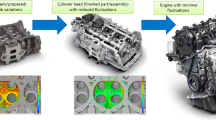Abstract
Laser metal deposition (LMD) of metallic powders, especially of high-strength nickel based alloys, allows for the manufacturing of components of high shape complexity and load capacity. However, high temperature gradients, induced during laser processing may have an impact on the product quality, especially when it comes to the geometrical accuracy of thin-walled components. This paper aims to provide a modelling approach of the heat effects during LMD manufacturing of a thin-walled virole aero-engine structure, in order to calculate possible shape deviations compared to the target CAD geometry. Hereby, a model reduction method is facilitated which allows the finite element analysis of such larger components in reasonable time. Major process characteristics as heat input, molten region geometry, material deposition (i.e. layer thickness), temperature dependent material and powder properties, phase transformation, process sequence and convection effects are taken into account. The proposed model aims to decrease time consuming trial-and-error testing effort during process design and development by providing reliable results on the shape accuracy of components. The computed final shape of the final product was compared to 3D measurements on a real demonstrator virole component.












Similar content being viewed by others
References
Ding D, Pan Z, Cuiuri D, Li H (2015) Wire-feed additive manufacturing of metal components: technologies, developments and future interests. Int J Adv Manuf Technol 81:465–481
Nowotny S, Scharek S, Beyer E, Richter KH (2007) Laser Beam Build-Up Welding: Precision in Repair, Surface Cladding, and Direct 3D Metal Deposition. J Therm Spray Technol 16:344–348
Zhang K, Shang XF, Liu WJ (2011) Laser metal deposition shaping system for direct fabrication of parts. Appl Mech Mater 66–68:2202–2207
Zhang A, Qi B, Shi B, Li D (2015) Effect of curvature radius on the residual stress of thin-walled parts in laser direct forming. Int J Adv Manuf Technol 79(1):81–88
Sridharan N, Chaudhary A, Nandwana P, Babu SS (2016) Texture evolution during laser direct metal deposition of Ti-6Al-4V. JOM 68(3):772–777
Khademzadeh S, Parvin N, Bariani PF (2015) Production of NiTi Alloy by direct metal deposition of mechanically alloyed powder mixtures. Int J Precis Eng Manuf 16(11):2333–2338
Mercelis P, Kruth JP (2006) Residual stresses in selective laser sintering and selective laser melting. Rap Prototyp J 12(5):254–265
Zaeh MF, Branner G (2010) Investigations on residual stresses and deformations in selective laser melting. Prod Eng 4(1):35–45
Ng GKL, Jarfors AEW, Bi G, Zheng HY (2009) Porosity formation and gas bubble retention in laser metal deposition. Appl Phys A 97:641–649
Tobar MJ, Amado JM, Lamas J, Yáñez A (2010) Effect of processing parameters in manufacturing of 3D parts through laser direct metal deposition. In: Proceeding 36th international MATADOR conference, Manchester, UK, 2010. Springer, London, pp 451–454
Mahamood RM, Akinlabi ET (2015) Processing parameters optimization for material deposition efficiency in laser metal deposited titanium alloy. Lasers Manuf Mater Process 3:9–21
Choi J, Chang Y (2006) Analysis of laser control effects for direct metal deposition process. J Mech Sci Technol 10(10):1680–1690
Song L, Bagavath-Singh V, Dutta B, Mazumder J (2012) Control of melt pool temperature and deposition height during direct metal deposition process. Int J Adv Manuf Technol 58:247–256
Song X, Xie M, Hofmann F, Illston T, Connolley T, Reinhard C, Atwood RC, Connor L, Drakopoulos M, Frampton L, Korsunsky AM (2015) Residual stresses and microstructure in powder bed direct laser deposition (PB DLD) samples. Int J Mater Form 8:245–254
Papadakis L, Loizou A, Risse J, Bremen S, Schrage J (2014) A computational reduction model for appraising structural effects in selective laser melting manufacturing. Virtual Phys Prototyp 9(1):17–25
Labudovic M, Hu D, Kovacevic R (2003) A three dimensional model for direct laser metal powder deposition and rapid prototyping. J Mater Sci 38(1):35–49
Zhu G, Zhang A, Li D, Tang Y, Tong Z, Lu Q (2011) Numerical simulation of thermal behavior during laser direct metal deposition. Int J Adv Manuf Technol 55(9):945–954
Radaj D (1992) Heat effects of welding. Springer, Berlin
Leblond JB (1984) A new kinetic model for anisothermal metallurgical transformations in steels including effect of austenite grain size. Acta Metall 32(1):137–146
SYSWELD (2006) Sysweld user’s manual. ESI Group, Paris
Biceroglu O, Mujumdar AS, van Heiningen ARP, Douglas WJM (1976) Thermal conductivity of sintered metal powders at room temperature. Lett Heat Mass Transf 3:183–192
Acknowledgements
The investigations and results presented in this paper were accomplished in the framework of the MERLIN Project which has received funding from the European Commission’s 7th Framework Programme FP7 2007–2013 under the Grant agreement 266271. Project website: http://www.merlin-project.eu.
Author information
Authors and Affiliations
Corresponding author
Rights and permissions
About this article
Cite this article
Papadakis, L., Hauser, C. Experimental and computational appraisal of the shape accuracy of a thin-walled virole aero-engine casing manufactured by means of laser metal deposition. Prod. Eng. Res. Devel. 11, 389–399 (2017). https://doi.org/10.1007/s11740-017-0746-3
Received:
Accepted:
Published:
Issue Date:
DOI: https://doi.org/10.1007/s11740-017-0746-3




